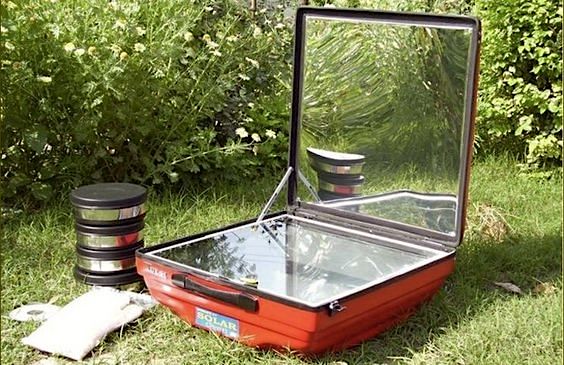“You know what was the best experiment I had from the solar cooker?” My cousin, Nikki Tai intrigued me while remembering the whole scenario from her box of childhood memories on our phone call. “My mom’s strawberry jam/syrup.” She elaborated that they once went for a family trip to Mahabaleshwar and brought bumper produce of fresh strawberries back home. Since it was a large quantity, it was tempting to make them last as long as possible. So, Aatya (her mom and my aunt) put thoroughly washed strawberries, added an equal amount of sugar in a vessel, and left it in the solar cooker for a few hours.
The result was this rich and intensely flavored, bright red syrupy jam. Now imagine how tedious it would have been to stand in the hot kitchen to make this fruit preserve and constantly stirring it with the fear of getting stuck and burnt in the pan?
The sustainable and straightforward equipment instantly became like an assistant in the conventional Indian kitchen.
It bypassed all these steps and created a hearty yet indulgent preserve without the need to keep an eye (and hands, for that matter) on the process.
Aatya’s love for experimenting with food and the utter convenience of solar cooking has always been as joyful as her work as a scientist. She has seen her mother use the solar cooker a few times. It has naturally guided her own daughter’s fondness for the humble equipment and the amplified taste it produces even if it’s an everyday dish like varan bhaat (lentils and rice). So much so that after getting married and shifting to hot-weathered Delhi, the first thing Nikki tai bought was a compact box solar cooker for herself. The large terrace of her first-floor home being on the same level makes it perfect for this kind of cooking.

The supremely comforting varan-bhaat has been the ultimate shared bond for solar cooking in all three generations. During the late 80s, my grandparents had just shifted to a newly constructed home in Indore. In the now-swanky colony of the city glutted with buildings, the house was then surrounded by empty plots, abundant open spaces, and ample sunlight. During this time, my grandpa happened to visit a solar equipment-focused fair. Since the salespersons gave dal rice as an uncomplicated suggestion for this relatively new kitchen equipment, my grandmother regularly used to cook it for a few years. Later on, both aatya and tai recall that during their years living in CAT (now RRCAT) quarters in Indore, several residents owned solar cookers under a scheme. Since Aatya was working and at the same time had to ensure her children get a nutrition-packed meal every day after school, the solar cooker proved to be valuable and practical.
They reminisce about the bloomed white rice along with piping hot dal and vegetables they used to devour for lunch.
Nikki tai recalls, “We were around 6-8 years old. And when mom used to go to the office, after school, we used to go to a neighboring aunty in the colony. So in the morning, mom used to pack lunch boxes for both of us with raw rice, dal, mixed vegetables, and seasonings and gave them to aunty before leaving. And when she cooked food for her own family, she used to keep our boxes as well. By afternoon, it used to get cooked!” Giggling on the call, she added, “Solar energy is anyway free, so there was no problem! Plus, mom didn’t have to practically cook anything in a hurry during the daily morning madness.”
She also told me that the proteins in dal and the carbs in rice, when soaked for a long time, break down and stay retained in a better way, which gives a distinct taste and increased nutrition. “That particular flavor you cannot get if you pressure cook,” she stressed. While talking she realized that she could also provide nourishing food via a solar cooker for her infant daughter while working and managing other multiple things at home. Aatya backed up the notion later on a separate call. It was two birds with one stone - low stress in the morning and a flavorful, nutritious lunch for the kids.
Nikki tai adds, “Another best thing I like is solar toasted peanuts. Toasting peanuts on a stovetop is a pain. And of course, if we toast them on high heat, they will quickly go black on the outside and remain undercooked inside, and on low heat, we are stuck to continue stirring it until done. So the best solution is to just keep the raw peanuts in the sealed black boxes in the morning, and by evening they get toasted so well without any burn marks. And uniformly deep-roasted crunchy peanuts are just amazing!”
Several familiar anecdotes about cooking in a solar cooker made perfect sense to all three. Toasting sooji or rava, cooking chhole, soups, and vegetable stews became common. All the tedious stirrings, mixings, and toastings were effortlessly avoided using a solar cooker.
Although my grandmother’s attempts were limited to the previously listed items, aatya and Nikki tai incorporated this ecological piece of equipment even during festivals and special occasions. For instance, the uncooked paper poha usually needs to be roasted adequately on a stovetop for making chivda during Diwali, but Aatya used to simply spread them on a butter paper inside the solar box, and the rest was all sun’s responsibility to make it crisp! Her favorite thing is to make the besan ladoos. The recipe follows the same procedure of roasting besan in the cooker, which she says makes a lot of difference in the aroma and the taste of laddoos. Even the chakli bhazani (multigrain flour mixed with ground spices) got roasted and accentuated the taste so well in it. Nikki tai on the other hand simply adds a lump of jaggery and dry fruits or sesame to make a healthy and scrumptious barfi. In the solar cooker, the added ingredients get toasted and jaggery gradually melts as the sunlight morphs it into a delicious sweet brown confection.
When it comes to cooking in a solar cooker, you need to remember that it is ultimately a slow approach. You will usually need to have a gap of 4-5 hours between the cooking part and finally the part where you enjoy eating it. And with Indian cooking tadka (tempering) is essential, beginning with a stovetop and later continuing to cook in the solar can be easily done. Another thing with it is that even if you begin the cooking in the morning, the food can’t be called stale by the time it gets cooked i.e. around evening. Beyond this, it can also act as a container for setting homemade curd during low sunlight and even a vegetable/fruit dehydrator.
“You need to pre-plan your meals a little if you’re cooking in a solar cooker,” Aatya states. Due to the slow process, you need to pre-prep everything in the morning and put it in the cooker. By afternoon or evening, all the dishes are ready to eat. The best part according to her is that the effort is inversely proportional to the heightened flavor one gets as an outcome. “Once I got the hang of it, it felt like I should cook everything in it.”
After both the calls, I realized that my family has already been subconsciously taking sustainability into practice for so many years before sustainability even became a trend. It evolved into an important part of our daily lives. It’s not only that I’m exulting about the equipment based on my relatives, but I’ve also had a first-hand experience of eating solar-cooked comfort food.
I remember it was a giant mountain of fluffy, fragrant rice on the plate and piping hot dal on top at my school friend’s place. It was an irresistible volcano of flavors that hit the right spot.
Besides, this is a wonderful way to start teaching the basics of cooking to kids at an early age since it is hazard-proof gear. It also comes as a savior for working women and men for that ever-dwindling balance between work stress and having a healthy meal each day. Whether for young or old, for a hobby or an emergency, solar cooking is something that can transform a bounty of food, each bite more delicious than the last one.
They reminisce about the bloomed white rice along with piping hot dal and vegetables they used to devour for lunch.
Nikki tai recalls, “We were around 6-8 years old. And when mom used to go to the office, after school, we used to go to a neighboring aunty in the colony. So in the morning, mom used to pack lunch boxes for both of us with raw rice, dal, mixed vegetables, and seasonings and gave them to aunty before leaving. And when she cooked food for her own family, she used to keep our boxes as well. By afternoon, it used to get cooked!” Giggling on the call, she added, “Solar energy is anyway free, so there was no problem! Plus, mom didn’t have to practically cook anything in a hurry during the daily morning madness.”
She also told me that the proteins in dal and the carbs in rice, when soaked for a long time, break down and stay retained in a better way, which gives a distinct taste and increased nutrition. “That particular flavor you cannot get if you pressure cook,” she stressed. While talking she realized that she could also provide nourishing food via a solar cooker for her infant daughter while working and managing other multiple things at home. Aatya backed up the notion later on a separate call. It was two birds with one stone - low stress in the morning and a flavorful, nutritious lunch for the kids.
Nikki tai adds, “Another best thing I like is solar toasted peanuts. Toasting peanuts on a stovetop is a pain. And of course, if we toast them on high heat, they will quickly go black on the outside and remain undercooked inside, and on low heat, we are stuck to continue stirring it until done. So the best solution is to just keep the raw peanuts in the sealed black boxes in the morning, and by evening they get toasted so well without any burn marks. And uniformly deep-roasted crunchy peanuts are just amazing!”
Several familiar anecdotes about cooking in a solar cooker made perfect sense to all three. Toasting sooji or rava, cooking chhole, soups, and vegetable stews became common. All the tedious stirrings, mixings, and toastings were effortlessly avoided using a solar cooker.
The solar cooker is like a supporting actor that complements the main character in the kitchen’s arena. It truly takes multitasking in the kitchen to another level.
Although my grandmother’s attempts were limited to the previously listed items, aatya and Nikki tai incorporated this ecological piece of equipment even during festivals and special occasions. For instance, the uncooked paper poha usually needs to be roasted adequately on a stovetop for making chivda during Diwali, but Aatya used to simply spread them on a butter paper inside the solar box, and the rest was all sun’s responsibility to make it crisp! Her favorite thing is to make the besan ladoos. The recipe follows the same procedure of roasting besan in the cooker, which she says makes a lot of difference in the aroma and the taste of laddoos. Even the chakli bhazani (multigrain flour mixed with ground spices) got roasted and accentuated the taste so well in it. Nikki tai on the other hand simply adds a lump of jaggery and dry fruits or sesame to make a healthy and scrumptious barfi. In the solar cooker, the added ingredients get toasted and jaggery gradually melts as the sunlight morphs it into a delicious sweet brown confection.
When it comes to cooking in a solar cooker, you need to remember that it is ultimately a slow approach. You will usually need to have a gap of 4-5 hours between the cooking part and finally the part where you enjoy eating it. And with Indian cooking tadka (tempering) is essential, beginning with a stovetop and later continuing to cook in the solar can be easily done. Another thing with it is that even if you begin the cooking in the morning, the food can’t be called stale by the time it gets cooked i.e. around evening. Beyond this, it can also act as a container for setting homemade curd during low sunlight and even a vegetable/fruit dehydrator.
“You need to pre-plan your meals a little if you’re cooking in a solar cooker,” Aatya states. Due to the slow process, you need to pre-prep everything in the morning and put it in the cooker. By afternoon or evening, all the dishes are ready to eat. The best part according to her is that the effort is inversely proportional to the heightened flavor one gets as an outcome. “Once I got the hang of it, it felt like I should cook everything in it.”
After both the calls, I realized that my family has already been subconsciously taking sustainability into practice for so many years before sustainability even became a trend. It evolved into an important part of our daily lives. It’s not only that I’m exulting about the equipment based on my relatives, but I’ve also had a first-hand experience of eating solar-cooked comfort food.
I remember it was a giant mountain of fluffy, fragrant rice on the plate and piping hot dal on top at my school friend’s place. It was an irresistible volcano of flavors that hit the right spot.
Besides, this is a wonderful way to start teaching the basics of cooking to kids at an early age since it is hazard-proof gear. It also comes as a savior for working women and men for that ever-dwindling balance between work stress and having a healthy meal each day. Whether for young or old, for a hobby or an emergency, solar cooking is something that can transform a bounty of food, each bite more delicious than the last one.


